January 2022 was undoubtedly the mildest, driest and least wintry January I have experienced in my 19 years living in Aviemore. Although we experienced gales in the forms of named storms Malik and Corrie at the very end of the month, with no new snow and hardly a frost experienced, it felt more like April or sometimes even May, than January, and although it made getting around much easier than normal, I did miss the crisp frosts and snowy backdrops, and unfortunately it did mean that some bird species were displaced by the lack of snow, or were not acting in their 'normal' January manner, and were therefore more difficult to find than usual.
The days are lengthening noticeably now, with up to 8-9 hours of usable daylight, and dawn (for the Black Grouse) is still a relatively sociable 8am, with dusk at around 5pm.
Full-day local safari bird lists usually top-out in the 30's or 40's, though a trip to the nearby (one hour by car ) Moray Coast (when allowed) can boost this total considerably, whilst mammal day lists can vary between 3 and 8 species, depending on the time of our start and number of habitats visited, with early starts usually proving to be best.
 |
| The upper River Spey |
To give you an idea of what you may realistically hope to see if you are considering a future January visit, I hope the following more detailed information, illustrated with photos taken at sites in and around the Cairngorms National Park, and sometimes further afield, by myself, my friends or my safari clients this month and in previous January's will help....clicking on the picture enlarges it to full-screen.
Local speciality/upland bird species seen regularly during the month included:
Crested Tit, Red Grouse, Golden Eagle and Dipper, whilst Black Grouse were occasionally seen at or soon after dawn at traditional lek sites, and we also had a few decent sightings of Golden Eagle and a couple of views of White-Tailed Eagle.
Local winter visiting birds were represented by Redwings and Fieldfares, family groups of Whooper Swans, several species of 'grey' Geese, and plenty of Bramblings and Redpolls were also seen...
Mammal species seen regularly included:
Red Squirrel, Red Deer, Reindeer, Roe Deer, Mountain Goat , Rabbit and (white) Mountain Hare.....with just a couple of (mainly dawn) views of Brown Hare , a few brief glimpses of Bank Vole underneath bird feeders, and one sighting of (introduced) Fallow Deer....
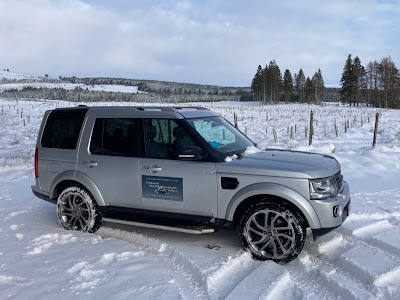 |
| A snowy safari adventure - Thank goodness for 4-wheel drive! |
January 2022 bird sightings in more detail:
Up in the glens...
 |
| Midwinter in a local upland glen |
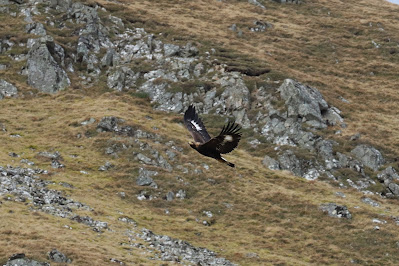 |
| Golden Eagle by Bob Smith |
 |
| Golden Eagle by Bob Smith |
Although sightings of Eagles were a little less frequent when compared to the usual annual peak viewing time of the last 3 months, both Golden Eagle and White-Tailed Eagle were seen several times in favoured local glens this month. It was great to get my 'year-tick' of both of these iconic and awesomely impressive birds by mid-month, and although most views were at some distance, we got incredibly lucky on the 18th, when a young Golden Eagle, distracted by a 'mobbing' Red Kite, passed low over our heads, giving sensational close-up views - a truly magical moment!
 |
| Common Buzzard |
 |
| Red Kite |
The regular 'raptor back-up cast' of Kestrel, Sparrowhawk, Buzzard , Red Kite, and even the occasional Hen Harrier and Goshawk should not be forgotten though, as all were seen and enjoyed at least once this month, though Merlin and Peregrine have yet to be encountered on my safaris this year...
Up on the moors....
 |
| A local upland heather moorland |
 |
| Displaying Black Grouse |
Black Grouse are one of my favourite local speciality birds, and always prove popular with my safari clients, especially from January to May when they usually display and lek at dawn. However, our early morning visits to their traditional 'lek' sites gave 'patchy' results this month, with a few 'no shows' offset by up to 10 cock birds showing beautifully on one occasion...please be aware though, that they are easily 'spooked' and legally protected from disturbance, so we have to keep a respectable (and lawful) distance away...
 |
| Red Grouse |
 |
| Red Grouse |
Still on the moors, the Red Grouse are becoming a little easier to see each week now, as the cock birds become ever bolder, often posturing aggressively from a raised position, and calling loudly to establish a territory and attract a mate, often with their red 'eyebrows' bulging impressively.
In the forests...
 |
| Early morning in the ancient Caledonian forest |
 |
| Crested Tits by Bob Smith |
 |
| Crested Tit by Bob Smith |
In the Caledonian pine forests, although they were not as reliable as normal, our local Crested Tits occasionally showed well at my favourite forest feeding stations, especially soon after dawn, and particularly on the colder days, when they are presumably at their most desperate for food, with up to 2 of these true 'local specialities' showing at once...with several of my delighted safari clients seeing them for the first time, and we even managed a few decent photos.
It is well worth noting that the winter months (October-February) are actually the best time of year for seeing the 'wee Cresties', as these characterful little birds can be frustratingly secretive and unobtrusive during the breeding season, with sightings being much more difficult to obtain between March and September....
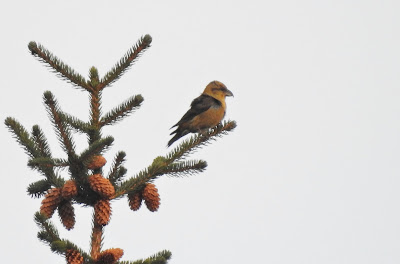 |
| Crossbill |
Still in the Caledonian forests, rather unusually ,we actually did better than normal for Crossbill sightings this month, with some decent sightings, and even a couple of rare, if annoyingly brief, photo opportunities!...mainly because this is breeding season for them, which means that this is your best chance to see them perched in treetops, often singing to establish a territory and attract a mate....
 |
| Hand-feeding a Coal tit |
A bonus by-product of regular winter feeding is often (especially on colder days) being able to feed the incredibly confiding Coal Tits and (sometimes) Great Tits by hand, an experience much enjoyed by my safari clients of all ages...
 |
| Capercaillie poo |
Sadly, despite many hours spent and miles walked in search of a Capercaillie this month, not a single sighting was achieved, though I did find the odd distinctive cigarette shaped poo formed mainly of pine needles, to give me a little encouragement to continue my quest...
Please note that Capercaillie numbers would still appear to be declining alarmingly, they are becoming very rare and elusive, and I would only rate our chances of seeing one on my safaris as "very slim" at best...
On the rivers...
 |
| A typical local river |
 |
| Dipper |
Our local Dippers are now most definitely in territorial mode, and we were lucky enough to see them posturing and displaying and often singing their distinctive 'scratchy' song from a prominent rock, often near a bridge, where they are likely to nest...
On the lochs...
|
 |
| Female Goldeneye by Steve Nicklin |
Star birds on the lochs during the winter are probably Goldeneyes, with the males now in their dapper breeding plumage, and the winter-visiting Whooper Swans, with a back up cast of Goosander, Teal, Wigeon and Tufted Ducks.
Up in the mountains....
 |
| The Cairngorm Mountains in winter |
 |
| Snow Buntings |
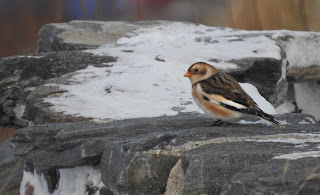 |
| Snow Bunting |
Snow Buntings can usually be seen at slightly lower levels in the winter months, and that was the case for the first week of the month, as the December snow lingered, and we enjoyed some good views of these attractive and endearing little birds. Unfortunately though, as the temperatures rose, the snow receded higher up the mountains and so , presumably did the Snow Buntings, meaning that a walk up to much higher levels was then required to have a chance of seeing them.
With the Cairngorm Funicular Railway still closed for major repairs, and the days so short now, I didn't venture up into the mountain-tops myself this month, but for future reference, a few Ptarmigan , still totally white, can sometimes be seen, up around the 'snow-line', usually sheltering in corries or on the leeward sides of ridges, out of the cold wind...
Winter-visiting birds seen in our area this month included:
 |
| Whooper Swans by Bob Smith |
 |
| Redwing |
 |
| Fieldfare |
 |
| Brambling |
 |
| Greylag Geese |
Whooper Swans, Grey Geese (Greylag , Pink-Footed and a few Barnacle), Redwings, Fieldfares, Bramblings , Redpolls, and a solitary Great Grey Shrike....
Other good/scarce birds seen/reported locally this month included:
The aforementioned Great Grey Shrike, a Nuthatch and one Waxwing...
A few photos of more common birds seen locally this month:
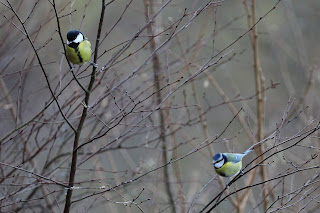 |
| Great Tit and Blue Tit by Bob Smith |
 |
| Male Chaffinch |
 |
| Jackdaws |
 |
| Red-Legged Partridges |
 |
| Linnets |
 |
| Robin |
 |
| Male Blackbird |
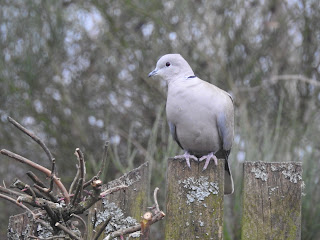 |
| Collared Dove |
 |
| Male Siskin |
 |
| Greater Spotted Woodpecker |
Adventures 'out of area':
 |
| Sunrise at Findhorn bay on the Moray Coast |
 |
| Purple Sandpipers |
 |
| Oystercatcher |
 |
| Turnstone |
 |
| Ringed Plovers |
 |
| Eiders |
 |
| Tree Sparrow by Bob Smith |
 |
| Snow Geese with Greylag Geese by Steve Nicklin |
 |
| Male Long-Tailed Duck by Steve Nicklin |
 |
| Red-Breasted Merganser by Steve Nicklin |
The Moray coast is only about an hour drive north of Aviemore, and trips to favourite reserves, lochs, bays and harbours gave good views of wintering birds such as Greylag Geese, Pink-Footed Geese, Brent Geese, Barnacle Geese, Whooper Swan, Shoveler, Wigeon, Teal, Pintail, Bar-Tailed Godwit, Knot, Golden Plover , Grey Plover , Ringed Plover, Purple Sandpiper, Redshank, Oystercatcher, Turnstone, Curlew, Common Scoter, Velvet Scoter, Long-Tailed Ducks, Eiders, and Slavonian Grebe, with the chance of scarce birds such as Tree Sparrow, and rarities such as Snow Geese, rare Scoters, and King Eider.....
January 2022 mammal sightings in more detail:
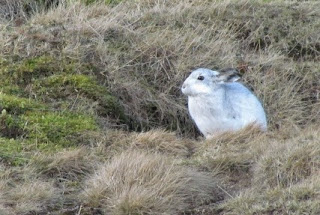 |
| Mountain Hare |
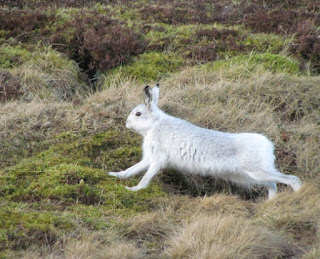 |
| Mountain Hare |
Star mammal for January is usually that much sought-after local speciality the Mountain Hare, and rightly so, as Britain's only native 'lagomorph' and with their distribution being restricted to just a few remote upland areas, seeing one is always a treat. I actually felt a bit sorry for the white Mountain hares this month, as much of the snow had melted by mid month, making them stand out rather conspicuously against the grassy upland backdrops, as , if we can see them, then aerial predators most definitely could too....
It should be noted though, that most of our views are at range through my telescope, and that a closer view or photo opportunity usually involves some rough uphill walking.
 |
| Red Deer stags |
In the same upland glens, Red Deer , mainly in large same-sex herds, can usually be seen, although a number of factors such as the weather, in particular the wind strength and depth of the snow, and whether there is any local shooting activity , can dictate whether we get nice close-up views, or distant views through the telescope....
 |
| Feral Mountain Goats |
Still up in the glens, another local speciality mammal, our Feral Mountain Goats can often seen on the same sheltered sides of the ridges as the Red Deer , and at this time of year it is not unusual to see them with the first , very cute, new-born youngsters ....
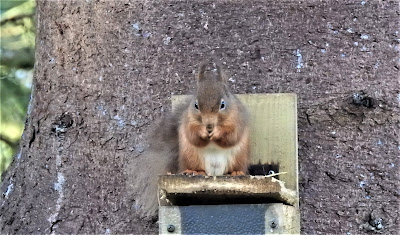 |
| Red Squirrel |
 |
| Red Squirrel |
Red Squirrels are a true Highlands speciality, and we are usually fortunate enough to see at least one on most of my safaris, mainly chomping on peanuts at forest feeding stations, but with the occasional random sighting whilst walking or driving in suitable habitat.
Although I managed a few early morning sightings of Brown Hare this month, mainly on the quieter farmland areas, they were very fleeting glimpses, and I failed to get a decent photo ...
 |
| Carrot time for Murdo means smiles all round |
Highland Coo's always prove to be popular with my safari clients, especially those who do not have them close to home, so don't be afraid to ask me if you fancy going to see them, and maybe even get to feed and 'pat' them, as I have a couple of great sites....
Rare/nocturnal mammals:
I get a few enquiries about the possibility of seeing Badgers and Pine Marten from my safari clients, many of whom I suspect are unaware that they are actually a largely nocturnal creature, and although we do get the occasional (maybe one or two a year) dawn glimpse of one, you would definitely have a much higher chance of seeing them at a specific dusk Badger/Pine Marten watching hide - Please contact me for more information.
Similarly, our inland Otters too are mainly active during the hours of darkness, and again, although we do get a few early-morning sightings on local lochs and rivers each year, looking for them feeding in a suitably quiet, kelp - filled bay on the coast on a rising tide, but at any time of day, would give you a much better chance.
Whilst we are still on the 'tricky to see stuff', the Scottish Wildcat too, as well as being incredibly rare now, is also generally nocturnal, and the fact that I have had a mere handful of (dawn or dusk) sightings in 17 years of providing wildlife safaris should give you an idea of how difficult they are to see.
Other wildlife:
Nothing to report in this category this month, I'm afraid....
 |
| Searching for the elusive Great grey Shrike in beautiful Glen Feshie |
News:
The BIG news is that all tourism/hospitality/activities in Scotland are open , are now largely free of restrictions except for the 1 metre social distancing recommendation, and that I have now completed nine (thankfully!) pretty busy and extremely enjoyable full months of safaris with clients with no major issues arising.
With all national travel restrictions lifted too, Scotland is officially 'open for business' for visitors from all over the UK, and from abroad.
At the time of writing, due to COVID distancing rules, and as restrictions have only recently been relaxed, we are still operating at reduced capacity, and are still trying not to mix unconnected groups, so we are currently recommending 'exclusive' safaris, at a small extra cost.
For those considering a visit, these wildlife/outdoor tourism websites may prove useful:
https://www.gov.scot/collections/coronavirus-covid
NatureScot (outdooraccess-scotland.scot)
Can Nature Help Health? | Nature Prescriptions - YouTube
Scotland, Yours to Enjoy. Responsibly. - YouTube
Cairngorms National Park Authority
 |
| Glen Tromie |
COVID-19
The Scottish Highlands has had very few COVID-19 cases in comparison to most of the UK, and on my safaris we tend to visit remote , wild habitats well away from the more popular tourist areas, and usually have very little interaction with other people, and this is something that I intend to continue.
 |
| Insh Marshes |
Summary:
Although I was only booked for 3 safaris this month, the generally friendly weather meant that I was able to get out and about wildlife-watching almost every day - not great for my bank balance, but good for my mental and physical wellbeing , my 2022 bird year list and photo portfolio, but with restrictions lifting, and more of a sense of normality returning, I am hopeful that I will get busier soon.....
 |
| "Extreme picnicking" is a (non-compulsory) option on my safaris |
Reviews:
Photos:
Prints of any of the photos (taken by myself) shown on this blog, going right back to 2015, reproduced on high quality photographic paper, with a choice of sizes up to A3, and satin pearl or glossy finishes available, can now be purchased from me at very reasonable prices. So if you see an image that might look nice in a frame (provided by yourself) on your wall, please make a note of the year and month of my blog in which it appeared, and email me for more information.
Gift Certificates:
| Safari gift voucher |











